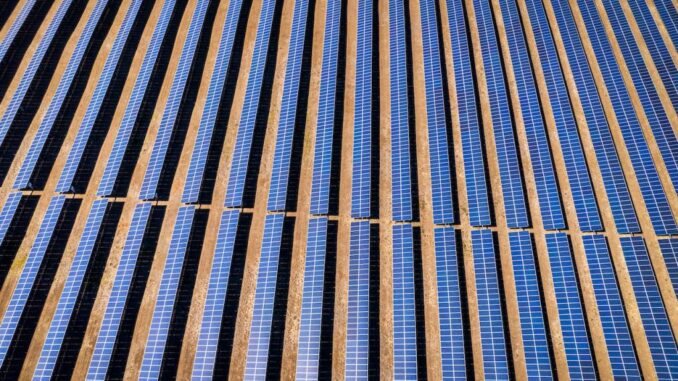
Illinois is looking to close the loop on its booming solar industry.
A new Illinois state law asks a task force to consider banning the dumping of solar components and batteries in landfills. If such a ban were enacted, it would leave stakeholders with less than two decades to come up with alternatives before defunct panels are expected to start piling up in the state.
The legislation, signed by Gov. J.B. Pritzker on July 28, follows a 2022 law that called for establishing a renewable energy recycling task force to study end-of-life options for a variety of clean energy technologies.
The hope, advocates and company officials say, is that attention to the issue now will lead to more affordable recycling options for the industry. Today, the cost of recycling a panel in the United States can be 10 to 20 times what it costs to landfill.
Solar panels — like televisions, computer monitors and many household electronics — contain trace amounts of heavy metals that means they can be considered hazardous materials. While they pose a relatively low risk in landfills, there’s been a push both from within the industry and from its political opponents to hold it to a higher standard.
Get connected
Every morning, thousands of energy professionals turn to our newsletters for the day’s most important news. Sign up for free to get the latest delivered straight to your inbox.
“Throwing it in a landfill is not what the promise of solar is,” said Saxon Metzger, senior project manager at NuLife Power Services, a California-based company that does decommissioning and repowering work. Metzger also formerly served as program director for Solarize Southern Illinois.
The life of a photovoltaic solar array is usually pegged at 25 to 30 years, and warranties often run for 25 years. The National Renewable Energy Laboratory estimates that the United States will have to deal with about a million tons of solar panel waste by 2030, as utility-scale and smaller solar installations reach the end of their productive lives.
Illinois lagged many coastal states in solar installation, so it has more time to figure out how to deal with solar waste. Large utility-scale solar began to blossom in Illinois about a decade ago, with the 23-megawatt Grand Ridge Solar Plant in LaSalle County among the first projects. That means in another 10 to 20 years, multiple utility-scale plants will be ready for decommissioning.
Meanwhile, since the passage of energy laws in 2017 and 2021, utility-scale, community and residential solar has mushroomed in the state, with the Solar Energy Industries Association predicting Illinois will add 6.5 gigawatts of solar over the next five years. The state’s largest solar farm, the 600-megawatt Double Black Diamond, is slated to go online next year.
That means by 2050, around the same time Illinois law calls for 100% of energy to come from renewables, tons of solar panels will also be at the end of their first phase of life. Experts say stakeholders should be planning now for that moment.
“We have to step up as an industry and start talking about what happens at the end of these systems, without the rose-colored glasses,” Metzger said.
He added that with utility-scale installations, there might be a solar manufacturer, an array owner, a landowner, a farmer renting the land, a private equity firm providing financing, and other key stakeholders involved in the conversation. Community and municipally owned solar arrays present a different cast of players.
In Illinois, utility-scale and large community solar arrays over 500 kilowatts must enter agricultural impact mitigation agreements with the state agriculture department, mandating that the land be restored to its former state. The agreements were originally required for pipelines and electric transmission lines, with solar and wind requirements later added. This basically means the solar array and all its components are removed, and farmland is returned to a condition suitable for farming.
“In many ways, the land is going to be better after we’re done because we’re generally going to plant native plants [under panels], and the land will have better microbial growth, better aeration,” said Kevin Borgia, Chicago-based vice president of external affairs and policy at SunVest Solar.
The owner of the array is responsible for the decommissioning, and the law mandates financial assurances be made to the county to cover decommissioning in case the owner goes bankrupt.
Metzger said that more thought needs to go into calculating the costs of decommissioning, including on large rooftop arrays that might involve power purchase agreements or leasing agreements.
“The problem is that few people know the true costs of decommissioning a solar asset,” he said.
Contracts should be written with end-of-life considerations in mind, NREL advises, and might include performance metrics rather than a number of years in determining an end date.
Panels often continue to generate significant energy after their rated lifespan, meaning individual owners could decide to keep using them or sell them on a secondary market. NREL in a 2021 paper noted that if panels are still producing energy, power purchase agreements and utility interconnection agreements could be renegotiated, with the understanding that the power will be decreased and more maintenance costs may be necessary.
Solar panel racks can be outfitted with new panels, reducing the amount of waste. But since solar technology has changed quickly in the last decade, there are likely to be compatibility challenges.
“The racking might not be plug and play,” Metzger said. “We like to think of solar as a huge puzzle set. For every solar panel, you have dozens of pieces of hardware, from the racking to the screws, to the wiring, to the wiring clips, to the cable trays, you’re looking at the average commercial solar array on top of a big box store being a 90,000-piece puzzle.”
Recycling the glass, aluminum and steel that make up the bulk of solar panels is a straightforward proposition. Recycling the chemically treated silicon and other materials that actually generate energy is trickier. Among other challenges, sealants and adhesives need to be burned up and acid is used to separate materials, as GreenBiz explained.
But increasing numbers of companies and research dollars are going into such “mining” of panels to put materials back into the supply chain.
Solarcycle, a California-based recycling firm, last year announced a partnership with Sunrun, a leading provider of residential solar in Illinois and nationwide, to recycle the vast majority of their panels, separating the materials and sending them back onto the market.
“Eventually we believe almost all panels will be made with mostly recycled materials,” said Solarcycle Chief Commercial Officer Jesse Simons. “That’s one of the amazing things about clean energy — unlike fossil fuels, which you burn once and are gone, panels and batteries can be endlessly recycled and are themselves renewable.”
The cost needs to come down, though, before recycled panels become the primary source of materials for new ones. NREL cited research by NuLife president and founder Cesar Barbosa showing it might cost about $140 more per kilowatt to decommission panels if they are recycled compared to refurbished and resold.
“The core challenge right now is that it costs anywhere from $10 to $15 less to landfill a panel,” Simons said. “With innovation, scale, and market forces we believe we can drive down the cost of recycling solar so that it becomes a no brainer to recycle rather than landfill.”
Most states, including Illinois, have no law requiring solar panel recycling. Washington state in 2017 passed a law — taking effect in 2025 — that mandates solar panel manufacturers offer a take-back program that results in at least 85% of panels being recycled, at no cost to consumers.
Solarcycle is among members of a recycling network launched by the Solar Energy Industries Association in 2016. The association says it is trying to expand the network and promoting “take-back” programs wherein solar suppliers have recycling programs for the panels they’ve sold. The nonprofit organization Sustainable Solar Resources similarly provides information on donating, recycling and reusing aging solar panels.
First Solar, a global company that manufactures thin-film modules in Ohio and other locations, is another member of the SEIA network. It has a “closed loop” recycling program at its plants that it says recovers 90% of the semiconductor material as well as the glass.
On its website, First Solar contends that recycling will eventually become more cost effective than other options.
“As the availability of sites and land for disposal become scarcer, and regulatory disposal requirements become more burdensome for all PV technologies, disposal costs will likely increase above costs for recycling,” the company says.
Illinois efforts
Last year Illinois passed the law calling for formation of a Renewable Energy Component Recycling Task Force that “should develop an end of life plan to recycle the components of renewable energy generating equipment and energy storage equipment to avoid pollution and material waste.”
The law says the task force will be made up of representatives of the Illinois Commerce Commission, Illinois Power Agency and Illinois Environmental Protection Agency, plus four members appointed by the governor representing a solid waste company, an environmental advocacy group and a renewable energy organization. Eight members will also be appointed by the two parties in the state legislature.
The majority of appointments to the task force have not been made, and the task force has not met.
Among other things, the task force is supposed to study solar end-of-life policies in other states, predict the impact of solar panels on landfills, and weigh the environmental and economic impacts of different types of recycling and decommissioning.
Simons said that while state action is welcome, the federal government should take the lead to help solar panel recycling become more affordable and more accessible.
“The main policy intervention we need is a set of catalytic short-term incentives for manufacturers and developers to recycle their panels and use recycled materials,” Simons said. “Much of this should come from the federal government since ultimately this is about national security and a more sustainable domestic supply for our future energy needs.”



